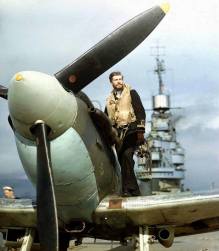
FAA pilot standing on the wing of a Seafire (adapted Spitfire with arrest capability). Note the “beard” and his wings on his sleeve above his rank.
The Fleet Air Arm (FAA) is a lessor known service in the bigger picture of World War 2, but no less important. In essence the Fleet Air Arm is the Royal Navy’s own Air Force, designed solely to be launched either at sea from aircraft carriers and ships or from shore bases on maritime based operations and in defence of the Royal Navy specifically.
The Royal Air Force was an independent arm of service from the Navy, it worked in conjunction with the Navy and the Army in joint commands, however it also worked in conjunction with the Navy’s own Air Force – the Fleet Air Arm.
The Fleet Air Arm is interesting as it flew a wide variety of very unique fixed wing aircraft in World War 2, and rotary wing aircraft post war (helicopters). The FAA aircraft in World War 2 were usually a little different to the ‘landed’ cousins as they to be specially adapted for operating at sea, they also had to be a lot more robust and made to ‘fold-up’ to store them on deck. They were even given different names, for the same equivalent Royal Air Force and US Air Force aircraft, an example is the famous ‘Spitfire’ had its named changed to ‘Seafire’ when serving with the FAA along with its special additions (like assesting or catapult hooks).
Even lessor known is the fact that the Fleet Arm has had a number of South Africans serve in it, and it all ties back to the strong Naval ties Britain – and the Royal Navy specifically – had with South Africa, especially as the Naval Base at Simonstown is near Cape Town, South Africa, and it was British sovereign territory during the war (a status that existed well in the 1960’s).
Like the South African Naval Forces personnel (SANF) finding themselves seconded to the Royal Navy or South Africans joining the Royal Navy directly as Royal Navy volunteer reserve – South African branch (RNVR), so too did many South Africans find themselves in the Royal Navy’s FAA either as SANF personnel or RNVR personnel.
It also unfortunately follows that when tragedy strikes the Royal Navy and its Air Force, there are South African losses. So, lets look at each of the South African men specifically lost serving the Fleet Air Arm, honour them by telling a little about their story, the squadrons they belonged and the unique FAA aircraft they flew. By looking at the sacrifice it will also give us a small insight into this very unique history of the FAA.

A unique book was written and illustrated by Derrick Dickens called ‘Stringbag to Shah’ on the history of the Fleet Air Arm, illustrated because many of the aircraft used by the FAA were not recorded in colour, or at best obscure with no record of paint schemes etc – and he wanted to bring these unique aircraft to living in vivid colour using his artwork. We’ll be using this unique catalog with the permission of the copyright owner.
In all there were 9 men according to current records (this can change as more research has been done on the honour roll) who were South African and died serving in the Fleet Air Arm. So lets start with the first South African man lost.
HMS Ark Royal
BOSTOCK, R S, Lieutenant, Royal Navy Fleet Air Arm 800 Squadron, HMS Ark Royal died 13 June 1940
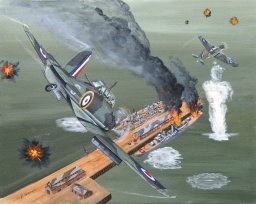
Blackburn Skua during Norway Operations by Derrick Dickens
At the time of Lt. Robert Bostock’s death, the HMS Ark Royal (a massive aircraft carrier), operated a number of FAA squadrons from its flight deck. In June 1940, FAA 800 Squadron was operating as part of the reaction force to the German invasion of Norway, 800 and 803 had dive-bombed the German Cruiser Königsberg on 10 April 1940 and sank it, flying the ‘Skua’.
800 squadron embarked on Ark Royal later that month, with the carrier providing air cover to the fleet and to Allied troops. 800 Squadron’s Skua’s claimed six Heinkel He 111 bombers shot down. On 13 June 1940, Ark Royal launched a dive bomber attack against the German Battleship Scharnhorst with 800 Squadron losing four Skuas out of six, along with Lt Bostock (our South African) and the Squadron’s Commanding Officer, Captain R.T. Partridge.
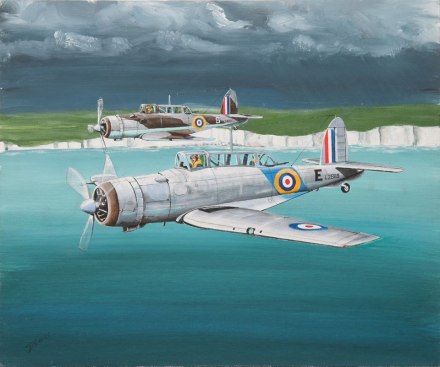
FAA Blackburn Skua B-24 by Derrick Dickens
“Too big too slow. too late, this was the Blackburn Skua and the reputation that followed it. Slow and big it certainly was by the standards of the day, It towered above the ground on a spindly under carriage, and was indeed a large piece of ironmongery to expect the under powered Perseus engine to hoist into the air. But considering the radical nature of its design by British standards at the time of its conception the Skua was competent enough, maintaining Blackburn’s name for rugged naval aircraft, and adequately fulfilling the demands of the specifications that had given it birth, but as a combat aircraft it was not very successful” (Stringbag to Shah by Derrick Dickens).
The next South African man lost was not a FAA pilot or navigator, he was a FAA aircraft mechanic;
HMS Hermes
RILEY, H, Air Mechanic, Fleet Air Arm, HMS Hermes, died 9 April 1942
At the time of Air Mechanics Riley’s death the HMS Hermes (also an aircraft carrier) was searching for the Japanese Imperial Fleet off Ceylon (now Sri Lanka) during the infamous Japanese ‘Easter Sunday Raid’ on Colombo – the Royal Navy’s own ‘Pearl Harbour’ and the South African Navy’s ‘Darkest Hour’ because of all the ships were lost with large South African Naval personnel on board – see this Observation Post link for the full story by clicking this link; The South African Navy’s ‘darkest hour’ is not recognised and not commemorated).
While sailing south off Batticaloa on the East Coast of Ceylon, HMS Hermes and its accompanying flotilla was by Japanese Carrier-Borne dive-bombers from the Imperial Japanese Task Force in the process of attacking the Naval Base at Trincomalee.
Approximately 70 Japanese aircraft were despatched to bomb the HMS Hermes which became an inferno and sank within ten minutes of being hit by numerous aircraft bombs.
At the time of her sinking the HMS Hermes was the home to No. 814 Squadron of the Fleet Air Arm flying the famous ‘Fairey Swordfish’ torpedo bomber, and these were the aircraft that Air Mechanic Harry Riley son of Alfred and Mary Ellen Riley, of Springs, Transvaal, South Africa, would have worked on.
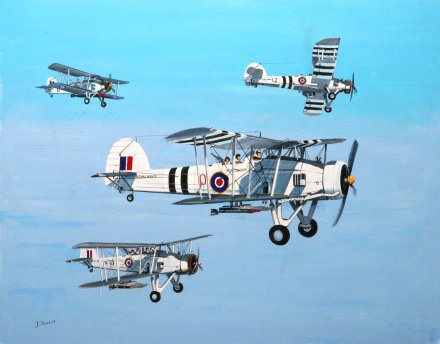
FAA Fairey Swordfish ‘Stringbags’ by Derrick Dickens
“Stringbag’ so named because of all the wires and stays. Archaic in appearance even when it first flew, the venerable Swordfish was the Fleet Air Arm’s premier torpedo-bomber at the outbreak of World War II and was destined to become a naval legend.
Having arrived at a stage of World War II when a biplane, was a very rare sight, despite appearances, this beautifully ugly aircraft was no anachronism, for the Fairey Swordfish, as it was named, had then a still vital role to play in World War II. The Swordfish had the distinction in fighting the Axis from the very first days of the war until victory for the Allies in Europe had been assured.
Swordfish first saw action in the Norwegian campaign, and went on to see service in the Mediterranean, the Western desert, Iraq, the Battle of the Atlantic, and in support of convoys bound for Russia, attacks on the French fleet at Oran in July 1940 following the D-Day evacuation, and attacks on the Italian fleet at Taranto, and the German battleship Bismarck. The Swordfish is credited with the destruction of a greater tonnage of enemy shipping than any other allied aircraft during World War II. In so doing, the Swordfish outlived and outfought aircraft which had been designed to replace it in service, and during this period created a record of the machine achievement in association with human courage that makes pages of the Fleet Air Arm’s history a veritable saga.” (Stringbag to Shah by Derrick Dickens).
The next South African man lost with FAA was lost from HMS Formidable.
HMS Formidable
CHRISTELIS, C, Sub/Lieutenant, Royal Navy Reserve FAA 803 Squadron, HMS Formidable, died 1 August 1942
FAA 803 squadron at the time of Sub/Lt. Christelis’ death was equipped with the Fairey Fulmar II and operated from Ceylon (now Sri Lanka) against the Japanese (also participating in the infamous sea battles surrounding Japanese Imperial Navy’s Easter Sunday raid against the Royal Navy), joining the HMS Formidable from April 1942. Sub/Lt. Cornelius Christelis was the son of Christos and Eleni Christelis, of Germiston, Transvaal, South Africa.
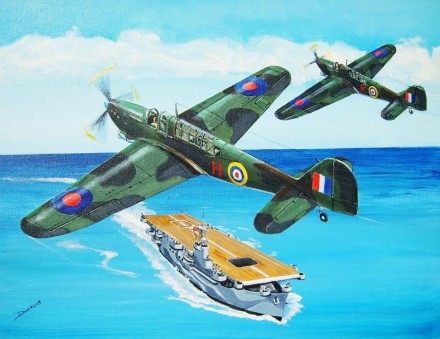
FAA Fairey Fulmar Mark II
“The first eight-gun fighter to enter service with the Fleet Air Arm, the Fulmar two-seat shipboard general-purpose fighter was designed at a time when the Admiralty held the view that navigational aids were inadequate to ensure the safe return of a single-seat fighter to its carrier in inclement weather, and that a navigator was, therefore, indispensable”.(Stringbag to Shah by Derrick Dickens).
The next South African man lost with FAA was also lost from HMS Formidable from FAA No. 888 Squadron around the same time as Sub/Lt. Christelis.
HMS Formidable
BROKENSHA, G W, Lieutenant, Royal Navy Fleet Air Arm 888 Squadron, HMS Formidable, died 11 August 1942
Lt Brokensha had an extensive career with the Fleet Air Arm, he flew Skua II with FAA 803 Squadron, taking part in Operation “Duck” on 17th April 1940 in defence of HMS Suffolk returning from Norway and from HMS Glorious he took part in numerous operations over Norway were he was even Mentioned in Despatches. From HMS Ark Royal he took part in numerous operations including attack on Scharnhorst in Trondheim Harbour on the 13 June 1940, for which he earned DSC. By 1942 he was posted to 888 Squadron flying Martlets as Senior Pilot, joining HMS Formidable on 1st February 1942. His death is a little mysterious, he is recorded as missing overboard from HMS Formidable, at night on the 11th August 1942.
FAA 888 squadron’s Marlet Mk II aircraft are an interesting addition to the Fleet Air Arms rich history, as they are essentially American Grumman Wildcats with a Royal Navy spin.
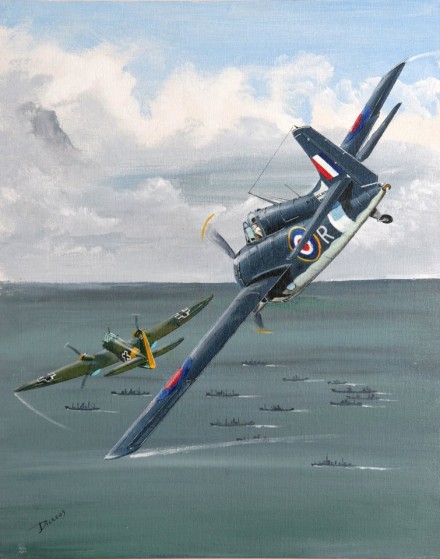
FAA Martlet Mk II by Derrick Dickens
“The Royal Navy’s effect upon the F4F Wildcat was considerable. The Fleet Air Arm introduced it to combat a year before Pearl Harbor, and exerted influence in its armament fit which ran contrary to opinion in US Navy squadrons. The Wildcat was the first truly modern fighter flown from British carriers, and represented an enormous leap forward in Royal Naval aviation” (Stringbag to Shah by Derrick Dickens).
The next South African man lost with the FAA was a very senior officer, a Lieutenant Commander on the HMS Indomitable.
HMS Indomitable
JUDD, F E C, Lieutenant Cmdr, Royal Navy Fleet Air Arm 880 Squadron, HMS Indomitable, died 12 August 1942
At the time of Lt Cmdr Judd’s death, the HMS Indomitable and its fleet of 880 Sea Hurricanes was involved with Operation Pedestal which revolved around securing supplies to Malta in the central Mediterranean. In early August the Royal Navy were engaged in heavy combat with German and Italian aircraft bombing their ships securing these vital supplies to the besieged island of Malta. The date Lt. Cmdr Judd died was a particularly heavy day of combat when 4 waves of German and Italian aircraft attacked the British Fleet, on 12th August the HMS Indomitable’s 880 Squadron FAA Sea Hurricane fighters had been in heavy aerial combat with Axis forces, with crew losses and in the evening the HMS Indomitable’s defensive screen was breached and she was hit by two 500 kg bombs; a 500 kg bomb penetrated the un-armoured portion of the flight deck, killing 50 and wounding 59 men causing damage that required her to withdraw from the fight.
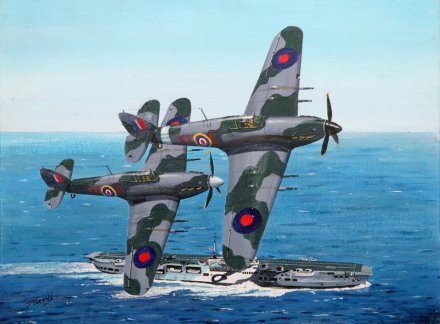
Sea Hurricane Mk II by Derrick Dickens
“That the Hawker Hurricane occupied a vital place in Britain’s history cannot be denied. Put simply, the Hurricane saved Great Britain in 1940; it was the right aircraft, at the right time, and flown by the right pilots. No one can deny the excellence of the Spitfire, nor that it one of the great fighting aircraft of World War II. Yet, outdated though the Hurricane may have appeared by comparison, its simplicity of concept and operation was such that it could be — and was – dispatched to any of the danger spots that spread like cancer during those first three years of the war when events threatened to engulf the Allied nations with disaster.
Overshadowed by the Spitfire, the Hurricane was slower, less manoeuvrable and half a generation older in terms of technology. What mattered was that it was available in numbers and could be adapted to a variety of roles. One of which was a carrier-based fighter version which the Navy dubbed the ‘Sea Hurricane’ (Stringbag to Shah by Derrick Dickens).
The next South African man lost was from the Fleet Air Arm’s No. 762 Squadron on the HMS Heron
HMS Heron
O’BRYEN, W S, Sub/Lt Royal Navy Fleet Air Arm 762 Squadron, HMS Heron, died 26 November 1942
At the time of S/Lt O’ Bryen’s death the HMS Heron and 762 Squadron were raining units. The HMS Heron is not a ship or carrier, it’s a shore base and one of the last of the Fleet Air Arm’s bases still in Operation now re-named Royal Naval Air Station Yeovilton in Somerset, England. It was used primarily during World War 2 as the home of No1. Naval Air Fighter School and later the Aircraft Direction Centre. The 700-series squadrons are generally experimental or training squadrons, which produce trained aircrew for the operational 800-series squadrons.
S/Lt William Stanislaus O’Bryen, the son of John and Ivy O’Breyen of Fynnland, Natal, South Africa is buried at the Fleet Air Arm’s Church in Yeovilton which contains a small number of FAA members killed in aviation accidents whilst training at HMS Heron.
It is unclear from records what aircraft S/Lt O’Bryen was involved with, however one of the more famous aircraft flown at HMS Heron used to train young pilots by the middle of the war was the famous Seafire, a naval adaption of the iconic Spitfire.
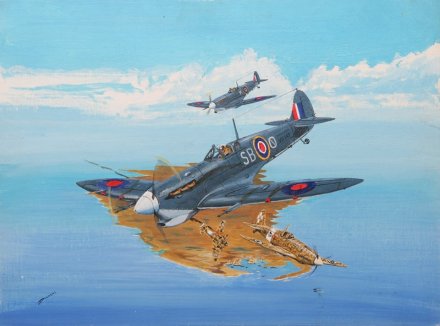
FAA Seafire MK 1B by Derrick Dickens
“The Seafire which in fact was little more than a “navalised” Spitfire, it was without any doubt the most effective British built naval fighter of World War 2, even though it had the reputation of not being suitable for the rigours of carrier operations. To some degree, this reputation was deserved for the Spitfire was of lightweight design, never intended for naval service, but it filled a gap till the specialist naval types in the shape of the Corsair and Hellcat arrived, in the mean time serving in major campaigns in the Far East, Africa and Europe” (Stringbag to Shah by Derrick Dickens).
The next South African man lost was from the Fleet Air Arm’s No. 851 Squadron on the HMS Shah, and he in fact was a member of the South African Navy, having been seconded to the FAA.
HMS Shah
 MACWHIRTER, Cecil J, Ty/Sub Lieutenant (A), Fleet Air Arm (Royal Navy) 851 Squadron HMS Shah, air crash, SANF, MPK 14 April 1944
MACWHIRTER, Cecil J, Ty/Sub Lieutenant (A), Fleet Air Arm (Royal Navy) 851 Squadron HMS Shah, air crash, SANF, MPK 14 April 1944
At the time of S/Lt Macwhirter’s death the HMS Shah had just completed an operation to the United States to collect equipment and airframes for twelve Avenger aircraft allocated to 851 Naval Air Squadron (FAA) on the 14th. The Shah sailed for Melbourne, departing Australia on 8th February 1944 for Cochin. On the 23rd February she disembarked her ferry load of American fighters; this included the Avenger airframes earmarked for 851 squadron.
851 squadron was to remain ashore until 6th March before rejoining the ship. The next two weeks would be spent working up her air department and flight deck parties; this was the first opportunity for flying operations to be carried out. HMS Shah arrived in Colombo on February 19th and 851 was flown off to RNAS Colombo Racecourse. Aircraft were embarked as required when further training; it was on such training that 851 suffered its first operational loss when Avenger FN813 stalled and ditched in the sea off the West coast of Ceylon while conducting a night anti submarine exercise on April 14th killing all three crew members, including S/Lt Cecil John Macwhirter, our South African son of Samuel and Elizabeth MacWhirter.
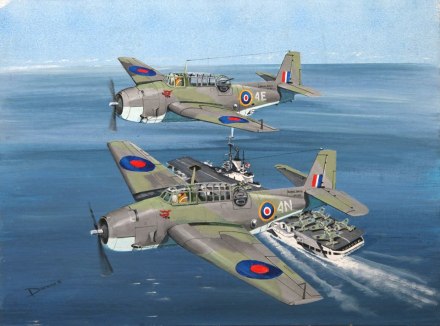
FAA Tarpon (Avenger) Mk 1 by Derrick Dickens
“When the Grumman Avenger first joined the Fleet Air Arm in 1943 it was very aptly named after a big ugly bird, the Tarpon. No 832 was the first Tarpon squadron to be formed and in December 1942 they sailed on HMS Victorious to America to commence training on the new torpedo bomber at the US Naval Air Station, Norfolk, Virginia They were equipped with US navy aircraft as the British machines were not ready Their first embarkation was on USS Saratoga and they landed up in the Pacific theater in April 1943. A month later they re-embarked on HMS Victorious for a period of operations in the Solomons. The FAA retained the name Tarpon until January 1944, when the name was changed back to the original American Avenger and became known as Avenger 1s” (Stringbag to Shah by Derrick Dickens).
The second last South African to be lost fighting in Fleet Air Arm was with 1772 Squadron (FAA) on the HMS Indefatigable, he was also a member of the South African Navy and seconded to the Fleet Air Arm.
HMS Indefatigable
LA GRANGE, Antony M, Sub Lieutenant (A), SANF, Fleet Air Arm (Royal Navy)1772 Sqn HMS Indefatigable, air operations, MPK 28 July 1945
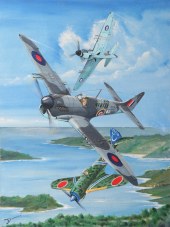
FAA Firefly Mk 1 by Derrick Dickens
In July 1945 1772 Naval Air Squadron, flying Fireflies, boarded HMS Indefatigable and joined the British Task Force 37 which then joined the US Task Force 38 in the northern Pacific for the final assault on the Japanese Mainland. The combined Task force comprised 14 Fleet Carriers, 25 Cruisers , at least five battleships, 75 Destroyers, and many other craft…. and 1300 aircraft. This was the largest naval force ever gathered in one area in history. The American Fleet comprised at least three-quarters of that combined fleet.
Many raids and bombardments took place in these last days of the war and losses were considerable despite the fact that the Japanese forces were very depleted by this time. The previous engagement had been largely American again and of course the European war had ended. This was the final massive battle against the remaining island possession occupied by the Japanese, Okinawa. Noteworthy in this engagement, which cost many American lives, was the Kamikaze and the Indefatigable received one Kamiikaze strike on its deck, killing several personnel.
The HMS Indefatigable went on to join the Americans in Tokyo Bay for the Peace Treaty signing. S/Lt. Antony Michael La Grange, the son of Mrs. I. B. La Grange, of Albertinia, Cape Province, South Africa is remembered on the Plymouth Memorial.
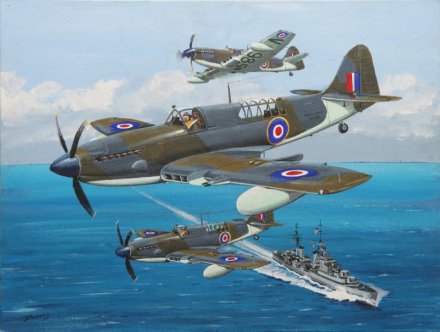
FAA Firefly Mk IV by Derrick Dickens
“The Fairy was conceived in the late “thirties”, blooded on the mid “Forties” withdrawn from production in the mid “Fifties” and finally retired in the mid sixties such was the 25 year lifespan of one of the most versatile aircraft to lift off a carrier deck. Combining performance, handling, maneuverability, and firepower never before displayed by a previous ship board aircraft, it wrote its own history due to its adaptability for roles and weapon loads unforeseen at the time of the creation of this handsome fighter – reconnaissance aircraft. The Firefly saw relatively limited action during World War Two, never the less it earned for itself a place in naval aviation history, for although the longevity of the Firefly was to be superceded, and its remarkable versatility was to remain peerless. 1,702 Fireflies were built over a period of 14 years, the most of them in post world war two guise which differed greatly in role and different in appearance from the original aircraft which made its operational debut on HMS Indefatigable, taking part on the attacks on the German battleship Tirpitz” (Stringbag to Shah by Derrick Dickens).
The final South African to be lost in World War 2 flying for the Fleet Air Arm was also a member of the South African Navy seconded to the FAA on HMS Landrail.
HMS Landrail
 WAKE, Vivian H, Ty/Lieutenant (A), FAA Fleet Air Arm (Royal Navy) 815 Squadron HMS Landrail, air crash, SANF, MPK 28 March 1945
WAKE, Vivian H, Ty/Lieutenant (A), FAA Fleet Air Arm (Royal Navy) 815 Squadron HMS Landrail, air crash, SANF, MPK 28 March 1945
By the time of Ty/Lt. Wake’s death, 815 Squadron had been reformatted in November 1944 at HMS Landrail, a shore base now called RNAS Machrihanish located 5 km west of Campbeltown on the western side of the Kintyre Peninsula in Scotland.
FAA 815 Squadron by this stage was flying Barracudas on anti-submarine operations, and doing DLT (deck landing training) on HMS Campania in preparation for the final operations in the Far East against Imperial Japan.
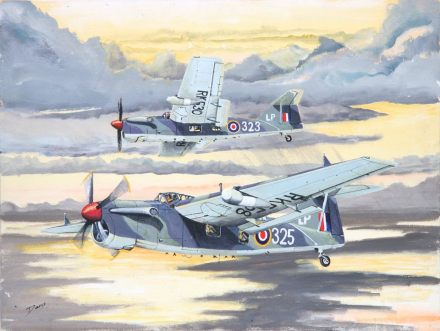
FAA Barracuda Mk V
“The Barracuda was a large ugly beast of an aeroplane, when its wings were folded it looked like some prehistoric bird straight out of Jurassic Park. Un-pretty, big bulky, solid and generally disliked by the aircrew, they were used to good effect in 1944 during attacks on the Tirpitz, which was lying crippled in Kaafjord, North Norway, after being damaged in an attack by midget submarines. From April 1944 Nos. 810 and 847 began operations in the pacific theatre on board HMS Illustrious. Barracudas were also heavily involved in dive bombing attacks on Japanese land and maritime targets, as well as raids against Japanese targets in Sumatra. They continued to support the Allies advance until the end of the war
Towards the end of the war a major redesign of the Barracuda was undertaken to provide an interim aircraft for use in the war against Japan, until the Fairey Spearfish became available. This development resulted in the Barracuda TR Mk V”. (Stringbag to Shah by Derrick Dickens).
In Conclusion
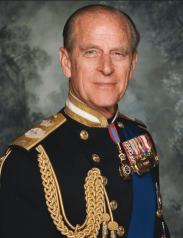 The best way to summarise the Fleet Air Arm, its commitment and sacrifice is in fact found in the forward of Derrick Dickens’ Stringbag to Shar’ written by none other than the Admiral of the Fleet, HRH Prince Philip, Duke of Edinburgh K.G., K.T., O.M., G.B.E.
The best way to summarise the Fleet Air Arm, its commitment and sacrifice is in fact found in the forward of Derrick Dickens’ Stringbag to Shar’ written by none other than the Admiral of the Fleet, HRH Prince Philip, Duke of Edinburgh K.G., K.T., O.M., G.B.E.
“When you look at the difficulties experienced by the pioneers of aviation Lord Cayley, the Wright brothers, Hiram Maxim and Colonel ‘Buffalo’ Bill; Cody – to get a machine to take off from mother earth and to fly through the air, it is not surprising that many people considered them to be extremely foolhardy, if not actually insane. To the far-sighted, the use of aircraft in war may have seemed obvious, it really needed the conviction of a saint to visualise the practical use of aircraft in a war at sea.
This splendid book traces the chequered history of naval aviation, and the extraordinary vision and determination of the designers, builders and pilots of naval aircraft against every sort of discouragement. It also illustrates the remarkable imagination of those who helped to develop all the ancillary equipment, such as aircraft carriers, catapults, arrestor wires, angled decks, ‘ski-jumps’, and all other gimmicks that enabled naval aviation to make a solid impact on the war at sea.
Looking through the illustrations in this book, it seems almost unbelievable that men could be found, not just to fly them, but to inflict damage on the enemy, and return to tell the tale.
The contribution of naval aviation to the war at sea during WW1 and WW2, may not have made the headlines in quite the same way as land-based aircraft, but, as the final days of the war against Japan demonstrated, the participation of naval aircraft was crucial to the ultimate allied victory”.
Related Work and Links
Related work of South Africans serving in the Royal Navy’s Fleet Air Arm
HMS Hermes “Dante’s Inferno”; Recounting South African sacrifice on the HMS Hermes
Dick Lord Dick Lord – the combat legend who took learnings from the Royal Navy’s Fleet Air Arm to the SAAF
Easter Raid The South African Navy’s ‘darkest hour’ is not recognised and not commemorated
Written and Researched by Peter Dickens, references from Wikipedia, The Commonwealth War Graves Commissioned, SAAF and RAF Honour Roll compiled by Graham du Toit, BBC People’s War, Fly Navy – HMS Shah, Fleet Air Arm Officers Association, CASUALTIES BY DATE and SHIP Compiled by Don Kindell sourced on the Royal Naval History Homepage.
Large extracts and paintings taken from “Stringbag to Shar 1938 to 2006” Compiled by Derrick Dickens. All the images used in this book are photographs of original paintings
by the author. These images may not be used anywhere else without the
specific permission of the copyright owner – Mr Peter Dickens. Images © Derrick Dickens 2008. (All original paintings).

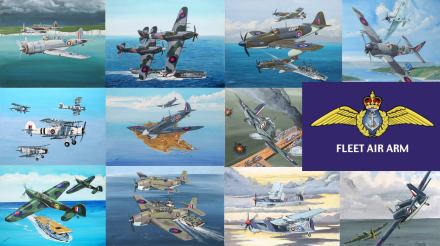
Well done Peter. A M la Grange commemorated here in East London. Both the Naval and the Civic War memorials record his name as Le Grange. Just checked Amazon and abebooks for a copy of Stringbag to Shah but nil listed. Any idea where a copy can be sourced please? Go well – Alan
LikeLike
Hi Alan, ‘Stringbag to Shah’ was self published by Derrick Dickens and is currently out of circulation. I have the copyright to it and when a publisher decides its worth it well put it back into circulation. I’m really happy that at least one man is remembered properly in his home town. Thank you.
LikeLike
Hi Mr Dickens. Could I please have your permission to share this post about the South African sacrifice in the Royal Navy, with an oldie group that I am on please ?
LikeLike
Certainly please go right ahead
LikeLike
Pingback: The first man to land on an aircraft carrier at sea was a South African | The Observation Post
Pingback: The South African Navy’s ‘elephant in the room’ | The Observation Post
Pingback: ‘Hurricat’ Hero | The Observation Post
Pingback: The silent South Africans in the silent service | The Observation Post